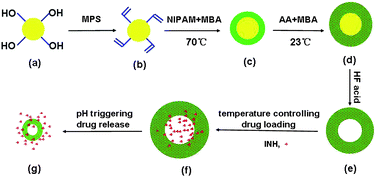Monodisperse temperature/pH dual stimuli responsive hollow nanogels with an interpenetrating polymer network (IPN) structure based on a poly(acrylic acid) (PAA) network and a poly(N-isopropylacrylamide) (PNIPAM) network (PNIPAM/PAA IPN hollow nanogels) were fabricated by a two-step sequential colloidal template polymerization and subsequent removal of the cavity templates. Their chemical composition, IPN structure and hollow structure were verified by Fourier transformation infrared spectroscopy (FTIR) and transmission electron microscopy (TEM), respectively. pH and temperature dependent particle sizes measured by dynamic light scattering indicated that the hollow nanogels have both pH and temperature dual stimuli responsive properties. Isoniazid (INH), an antitubercular drug, was loaded into PNIPAM/PAA IPN hollow nanogels by controlling the equilibrium temperature ensuring it is lower than their volume phase transition temperature, so that the drug loading capacity can reach 668 mg INH per gram of the hollow nanogel. It can be seen from the TEM results that the encapsulated INH is mainly located in the cavities of the hollow nanogels. In vitrodrug release studies showed that the INH loaded PNIPAM/PAA IPN hollow nanogels possess distinct acid triggered drug release behavior, which may make them suitable for a stomach-specific drug delivery system.

